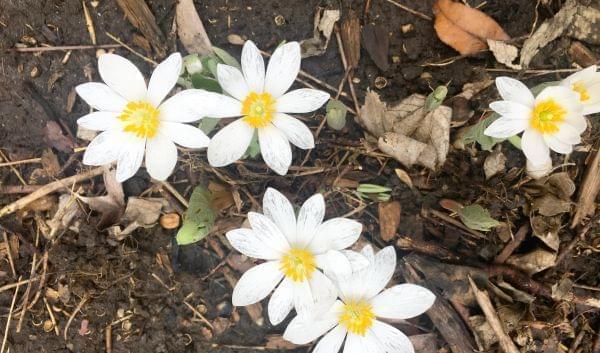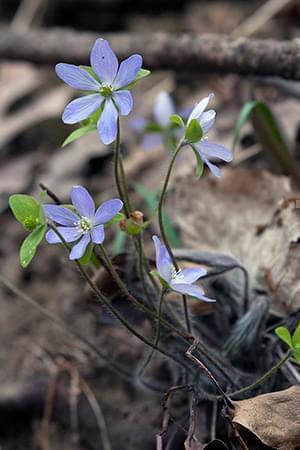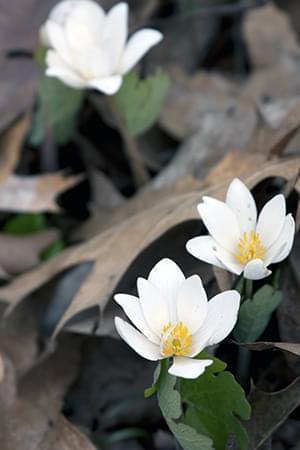Now is the time to catch woodland wildflower show in Illinois [from the archive]

The beauty of a single Virginia bluebell would be enough to draw me out to Allerton Park this month. But I am all the more compelled to go when I think of bluebells in context of the extended wildflower show that takes place each spring in the woodlands of Illinois.
It begins with a prelude in February, when skunk cabbage takes the stage. An unconventional beauty, perhaps best appreciated by botanists and the carrion flies that pollinate it, skunk cabbage generates its own heat, enabling it to grow right through the frosty soil of late winter.

A sharp-lobed hepatica in Allerton Park
The show gains momentum in March, as two prettier flowers make their entrance: Snow trillium, named for the fact it sometimes appears through the snow, and sharp-lobed hepatica, whose other name, liverleaf, calls attention to the deep reddish brown color taken on by its leaves as they persist through the winter. [Upper photo, sharp-lobed hepatica; lower, bloodroot. Both taken by author at U of I Allerton Park near Monticello.]
Over the course of April, another ten or more players fill the scene. Among them are bloodroot, whose inch-and-a-half wide white flowers bloom only for a day; Dutchman’s breeches, whose flowers resemble, well, you know; and spring beauty, a flower that makes up for being tiny by being numerous, and tolerating a wide range of growing conditions.
The show reaches its climax in early May, at which time an observer might count more than a dozen species flowering at once. These include idiosyncratic stars who may be more widely recognized by name than appearance, Solomon’s seal, Jack-in-the-pulpit, and blue-eyed Mary among them. In May, the woodland flower show retains none of its earlier subtlety, and the hiker who didn’t think to look for skunk cabbage or who overlooked hepatica blooming cannot help but pause at the sight of a bottomland forest carpeted in Virginia bluebells.
The Illinois woodland wildflower show winds down in June, as the trees above leaf out completely to claim the sun’s energy for themselves, and most of the players quietly disappear from the stage once the work of producing seeds is done. Although they are out of sight, they persist underground as bulbs or other structures, awaiting their cues the following year.
For me, the beauty of woodland wildflowers exceeds that of flowers “improved” for gardens by human art precisely because it developed without regard for our tastes, and because it is out there free for people to enjoy wherever they have access to intact wooded areas.

A bloodroot flower at Allerton Park
Of course, how Illinois’ woodland flowers fare in the future depends largely on how well we treat our woodlands. Few woodland flowers can be restored to an area once they have been eliminated by intentive logging, grazing or other development, so it is crucial to protect habitats where they still thrive. It is equally important that people maintain the existing quality of woodlands by helping to keep in check the exotic invasive plants that might otherwise overrun them.
Where to look
In Piatt County, the trails at Allerton Park and Lodge Park offer excellent opportunities for finding woodland flowers, but residents of Champaign-Urbana need go no further than Busey Woods to get a taste of what’s out there. In Vermilion County, try the Forest Glen Preserve, or any of mature woodlands within the state and county natural areas along the Middle Fork of the Vermilion River.

